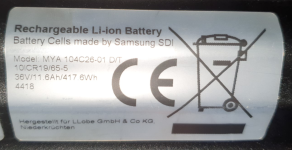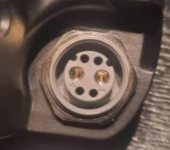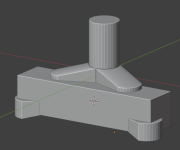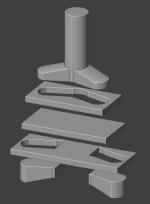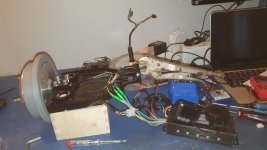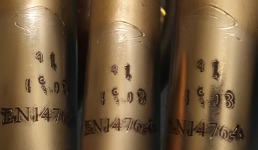Hello all!
Ive started collecting parts/planning for my first (mini) ebike/moped project and am looking for some input on the build.
An overview of my intent with this:
Fun of building.
And cruising, ive enjoyed old two stroke mopeds and a relatively new kit addon motorized bicycle.
Best case is that this project will let me commute about 16km/10 miles each way to and from work with comparatively little maintenance.
Setting the limits of the controller to 25km/h and a just enough amps to get there, for good range rather than racing.
Parts already collected:
The bicycle coil spring fork+head tube pictured below is one currently part of a bicycle ive picked up and will be widening the forks on to fit the fatter tire, the bit sticking into the frame in the pic will obviously not be there.
2x350w hoverboard motors bolted together, holes drilled, rim side adapters printed, just need the front rim to arrive so i can figure out how much to space the individual motors from each other so both tires will have the same profile.
2x36v 11ah batteries ive got for 50 bucks each, said to be unused which i can believe as there is not a scratch on the locating pins, the slots where the locking latches go or the connectors, will be switching out the connectors to XT60.
13 x 5.00-6 4pr tires specced for 30km/h and 200 kilograms.
Parts in the mail:
Front rim, brace disc and callipers.
1000w Brushless ebike speed controller with display (for configuration of speed and amp limts) and a thumb throttle, box goes inside the frame in front of the seat, display possibly also there, throttle as usual on the handlebars.
Parts yet to be gotten:
Seat, ill cut out the base from some plywood, shape it in foam to then stretch and staple leather or vinyl over it, its going to be the full length of the rear flat where the bicycle saddle is still visible in my reference image.
Front/rear lights and side reflexes, ill find something cheap and easy.
Probably tallish handlebars for a relaxed riding position.
Need to figure out a front axle, probably allthread and spacers as seems common on DIY minibikes.
And then onto the frame:

Ill be getting 3x2m lengths of 30mm square and 1x2m length of 25mm square tubing, both with 1.5mm walls
Two 30mm of which will have wedges cut in it to bend into the shape pictured, minus the front upright, totalling 1.88m each.
The third 30mm x 2m tube will be cut into the two front upright 435mm parts and leftovers will be used to widen the fork.
This should also leave enough for the foot rests, which im thinking will be a single bar that bolts on at the lower end of the front, as well as someplace else along the side or bottom for compact stowage for when the whole thing is put into the back of my car or whatever.
Im not 100% sure how wide i need to space the two sides yet as im still waiting for the front rim, ive got a measurement for the front rim itself. 122mm wide, but the seller doesnt give the hub width/outside of bearing to outside of the other bearing.
But thats not much of an issue as ill have a bit to do before ive get that far,
Whatever the distance i will be cutting the 25mm tubing to length for joining the two main parts of the frame at each bend.
Along with two or so extras under the seat for ease of mounting it+the batteries.
A brace above of and in front of the rear wheel for putting on a rear light and a fender.
A couple of braces along the bottom, perhaps for storage inside the frame?
A brace in the front where the diagonals join the upright to mount a blanking plate to protect the inside of the frame from unnecessary road dirt.
Im not a great welder but i can booger stuff together and will be putting in gussets at the main corners of the frame.
Am i going overkill? Am i going way light? Have i missed anything obvious?
-Thanks
Ive started collecting parts/planning for my first (mini) ebike/moped project and am looking for some input on the build.
An overview of my intent with this:
Fun of building.
And cruising, ive enjoyed old two stroke mopeds and a relatively new kit addon motorized bicycle.
Best case is that this project will let me commute about 16km/10 miles each way to and from work with comparatively little maintenance.
Setting the limits of the controller to 25km/h and a just enough amps to get there, for good range rather than racing.
Parts already collected:
The bicycle coil spring fork+head tube pictured below is one currently part of a bicycle ive picked up and will be widening the forks on to fit the fatter tire, the bit sticking into the frame in the pic will obviously not be there.
2x350w hoverboard motors bolted together, holes drilled, rim side adapters printed, just need the front rim to arrive so i can figure out how much to space the individual motors from each other so both tires will have the same profile.
2x36v 11ah batteries ive got for 50 bucks each, said to be unused which i can believe as there is not a scratch on the locating pins, the slots where the locking latches go or the connectors, will be switching out the connectors to XT60.
13 x 5.00-6 4pr tires specced for 30km/h and 200 kilograms.
Parts in the mail:
Front rim, brace disc and callipers.
1000w Brushless ebike speed controller with display (for configuration of speed and amp limts) and a thumb throttle, box goes inside the frame in front of the seat, display possibly also there, throttle as usual on the handlebars.
Parts yet to be gotten:
Seat, ill cut out the base from some plywood, shape it in foam to then stretch and staple leather or vinyl over it, its going to be the full length of the rear flat where the bicycle saddle is still visible in my reference image.
Front/rear lights and side reflexes, ill find something cheap and easy.
Probably tallish handlebars for a relaxed riding position.
Need to figure out a front axle, probably allthread and spacers as seems common on DIY minibikes.
And then onto the frame:

Ill be getting 3x2m lengths of 30mm square and 1x2m length of 25mm square tubing, both with 1.5mm walls
Two 30mm of which will have wedges cut in it to bend into the shape pictured, minus the front upright, totalling 1.88m each.
The third 30mm x 2m tube will be cut into the two front upright 435mm parts and leftovers will be used to widen the fork.
This should also leave enough for the foot rests, which im thinking will be a single bar that bolts on at the lower end of the front, as well as someplace else along the side or bottom for compact stowage for when the whole thing is put into the back of my car or whatever.
Im not 100% sure how wide i need to space the two sides yet as im still waiting for the front rim, ive got a measurement for the front rim itself. 122mm wide, but the seller doesnt give the hub width/outside of bearing to outside of the other bearing.
But thats not much of an issue as ill have a bit to do before ive get that far,
Whatever the distance i will be cutting the 25mm tubing to length for joining the two main parts of the frame at each bend.
Along with two or so extras under the seat for ease of mounting it+the batteries.
A brace above of and in front of the rear wheel for putting on a rear light and a fender.
A couple of braces along the bottom, perhaps for storage inside the frame?
A brace in the front where the diagonals join the upright to mount a blanking plate to protect the inside of the frame from unnecessary road dirt.
Im not a great welder but i can booger stuff together and will be putting in gussets at the main corners of the frame.
Am i going overkill? Am i going way light? Have i missed anything obvious?
-Thanks



